Introducing the perfect birthday cake for a small and intimate celebration: This fluffy white cake is filled with sprinkles and topped with a custardy cake batter French buttercream. This mini confetti layer cake is great for any occasion worth celebrating: birthdays, anniversaries, retirements, Fridays…
This small 6″ layered birthday cake serves 8-10 people.
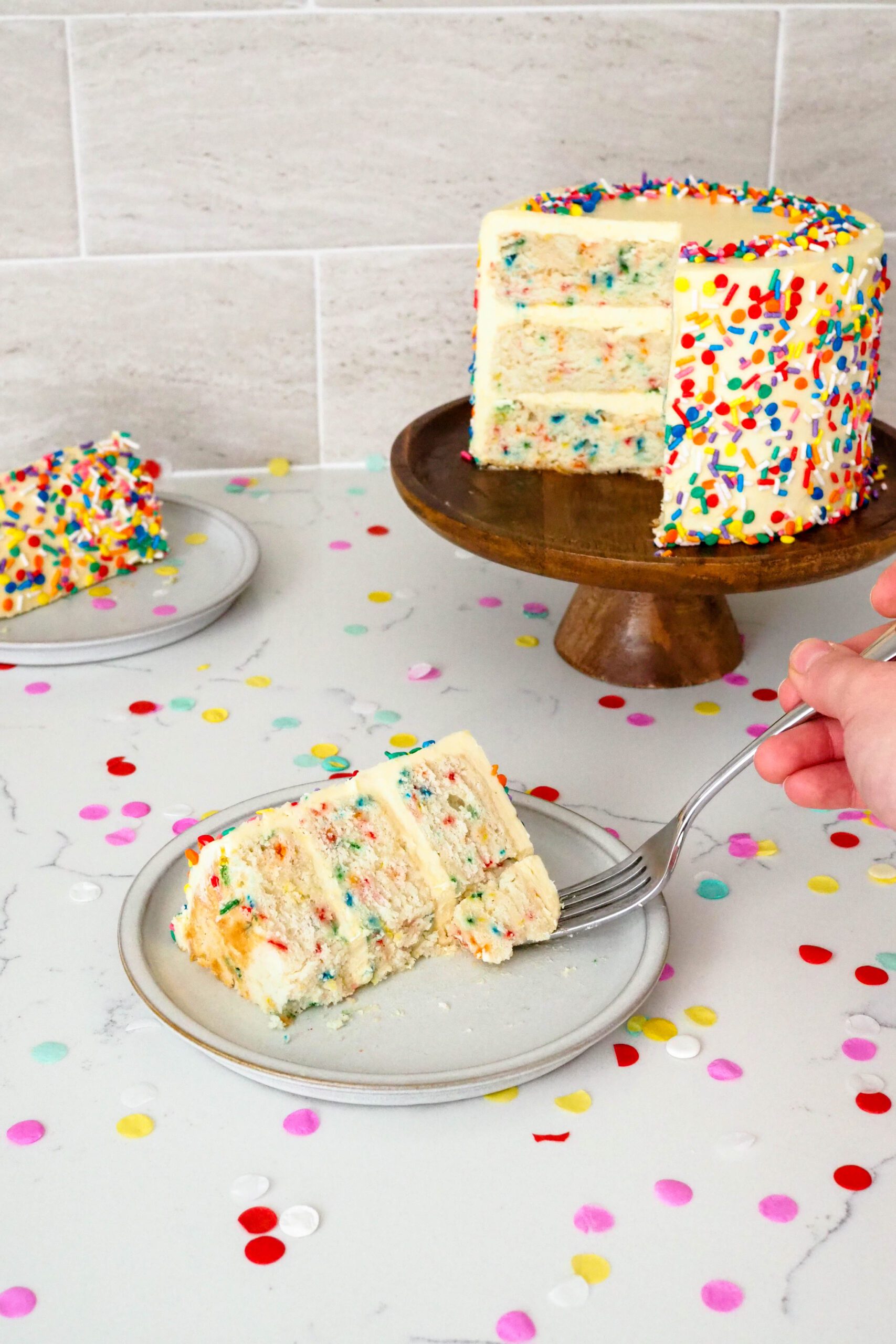
Ingredients for Mini Confetti Layer Cake
This white cake recipe has a few extra steps for ultimate fluffy cake goodness—but no unnecessary ingredients! With just a few upgrades (egg whites turned into meringue, American buttercream into French buttercream), this confetti cake goes from “yum” to “I can’t wait for the next birthday party!”
Ingredients for the Mini Confetti Layer Cakes
- Egg whites, from fresh eggs. Egg whites are whipped into a meringue. That’s what will give this cake its light and fluffy airiness, along with some structure.
- Granulated sugar. Granulated sugar will strengthen the meringue and prevent it from deflating too quickly and will also keep the entire cake moist.
- Unsalted butter. Use unsalted butter to keep your cake moist and not overly salty, as each butter brand uses a different amount of salt in each stick.
- All purpose flour. This recipe works well with all-purpose flour, not cake flour, to give the cake its structure.
- Baking powder. This white cake is light and fluffy due to the lift baking powder gives, along with the air from the meringue.
- Salt. Just a pinch helps to enhance all the flavors.
- Canola oil. There are no egg yolks in this recipe, so we need to add a little extra fat to make up for it. You may use any neutral oil you like in place of canola oil.
- Vanilla extract or vanilla bean paste. This cake is delicious even without vanilla extract, but I recommend adding it for an extra boost of flavor.
- Whole milk. The fat in whole milk works best with this cake, since it does not have the fat from the egg yolks. You may substitute 2% or 1% milk if needed, but I recommend using whole milk for the best texture.
- Rainbow sprinkles! The long, jimmies sprinkles like this are the best kind to use here.
Ingredients for the Birthday Cake Batter French Buttercream
- Egg yolks. Egg yolks give this buttercream a custardy richness like none other. Use the egg yolks reserved from the cake for a no-waste cake recipe!
- Granulated sugar. This is a great buttercream to make when you don’t have a lot of powdered sugar on hand.
- Water. Add a touch to the sugar to help the syrup heat evenly.
- Salted butter. This is what gives the buttercream its birthday cake batter flavor without any emulsifiers! Do not substitute unsalted butter.
- Vanilla extract. Necessary for a good vanilla buttercream.
- Powdered sugar. This helps to offset the saltiness of the buttercream and adds stability and flavor.
- Heavy cream. This helps reduce the saltiness of the buttercream and improve the texture.
Quick Tips for Prepping Mini Confetti Layer Cake
I combined two cake-making methods into one recipe for the lightest and fluffiest white cake I’ve ever tasted. First, whip the egg whites into a meringue. Then, reverse cream the dry ingredients and beat in the liquid ingredients. Finish by folding in the meringue. This method requires an extra bowl to hold the meringue, but the difference it makes is more than worth an extra minute at the sink.
Mixing Up the Confetti Cake Batter
Key things to note: Whip the egg whites with about half of the sugar. This will stabilize the meringue and prevent it from deflating as you reverse cream the other ingredients. I recommend using a stand mixer or hand mixer, as whipping egg whites to soft peaks can take a while without one.
Transfer the meringue to another bowl, then thoroughly whip out your mixing bowl to reverse cream the dry ingredients.
Reverse creaming combines all the dry ingredients in the cake with the fat before adding in any liquid. This coats the flour in fat, which is unable to properly hydrate. (That’s a good thing!) The flour can’t create nearly as much gluten, so instead of a tough and chewy crumb, you end up with a moist, tender crumb that melts in your mouth.
Pour the milk, canola oil, and vanilla into the mixer while on low, then beat for a minute until the batter is smooth. Scrape down the sides and bottom of the bowl to ensure there aren’t any sneaky lumps hiding out.
Then, add your sprinkles!
Finally, fold in the meringue. It won’t feel like it’s mixing at the start, but keep at it.
Use large strokes that hug the sides of the bowl to reduce deflating the meringue. Continue folding in the meringue until no streaks remain.
This process usually takes me no longer than two minutes.
Baking the Cakes
The easiest way to divide your cake into cake pans is to weigh how much batter you have in each pan. This is the best way to ensure even cake layers that all finish baking at the same time.
These cakes are small, so they don’t take long to bake. I use light-colored aluminum 6″ cake pans that heat incredibly evenly. If you’re using dark-colored pans, which absorb more heat, check on your cakes five minutes early.
Quick Tips for Prepping Birthday Cake Batter French Buttercream
French buttercream is more difficult to make than American buttercream, but there’s no reason why you shouldn’t be able to make it at home.
The number one problem people have with French buttercream is mixing the hot sugar syrup into the egg yolks quickly enough while the beater is beating fast enough without splattering it everywhere.
It’s easier than it sounds, I promise.
Making the Custard
The egg yolks should be at room temperature. If they’re cold, the sugar syrup will cool immediately upon contact.
Use level 2 or 4 on your KitchenAid or stand mixer—not just the “stir” option. Level 4 combines the syrup with the egg yolks quickly enough to prevent them from curdling but doesn’t splatter.
As you pour the syrup into the bowl, make sure it is running down the side of the bowl before it meets the yolks. That will prevent splatters and helps make sure all the syrup makes its way into the mixture. A small saucepan with a spout really helps this process along.
Keep pouring the syrup onto that same line of syrup in one slow and steady stream. Go slow enough so that there isn’t a puddle of syrup waiting to be incorporated. That puddle is hot, and it will begin to curdle the yolks if it’s not spread out evenly.
If your yolks end up curdling, don’t worry about it overmuch! You can always push the final product through a fine mesh strainer to get rid of any large lumps. No one will be the wiser!
Adding in the Salted Butter
A friendly reminder: Use salted butter. Unsalted butter just won’t have the same flavor.
When you’re ready to add the salted butter to the French buttercream, the bowl should be almost cool to the touch. The butter will melt if you add in the butter when the custard is warm. Then, the buttercream won’t whip up properly.
Ensure the butter is at room temperature. If your butter is too cold, it will not whip properly. If your butter is too warm, it won’t aerate easily and can turn out a bit dense.
The buttercream comes together more easily when the butter is introduced in pieces and not all at once. Once incorporated, the French buttercream will be dense until the next step.
Making the Buttercream Taste like Cake Batter
Finally, add in your vanilla, powdered sugar, and heavy cream. Beat them all together for no less than three minutes, and enjoy your wonderfully fluffy, one-of-a-kind, birthday cake batter French buttercream.
Can I Make this Buttercream with Unsalted Butter?
You can, but it’s not going to taste the same. I have attempted making this buttercream with unsalted butter, then compensating by adding salt during during the whipping stage. The buttercream turned out a bit grainy, and it contained unpleasant pockets of saltiness. This recipe needs salted butter for the flavor to turn out right.
Do I Need to Use a Candy Thermometer?
No, you don’t, but you will need a thermometer of some kind! A candy thermometer is certainly helpful (I love this inexpensive digital one from CDN) but not required. Any instant-read thermometer will do.
Quick Tips for Assembling Mini Confetti Layer Cake
Do not frost a partially-cooled cake. If running low on time, wrap a slightly warm cake in plastic wrap and put it in the fridge until it is fully chilled. Frosting and filling a warm cake will only result in goopy buttercream, a lack of structural integrity, and probably a few frustrated tears (speaking from experience!).
To layer your cake, place a dollop of birthday cake batter French buttercream on a cake turner and firmly press a cake round onto it. Apply another dollop of buttercream and press a white cake layer onto it. Pipe a ring of buttercream around the layer, then spread it evenly across the top of the cake layer. Use about ½ cup.
Then top with another cake layer, pressing lightly but firmly to seal it. Repeat.
Once your third layer is in place, spread a light coating of buttercream around the top and edges of the cake to seal in any crumbs. Refrigerate for at least 15 minutes, then frost with the remaining buttercream. Smooth with a bench scraper for perfect edges.
Dish Cleanup: Dish Mountain
I rate my recipe cleanups on a scale of 1 to 5. 1 is only a handful of dishes, and 5 is everything including the kitchen sink.
My mini confetti layer cake recipe has a cleanup rating of a 5. To cut down on the dishes you have to use and wash at one time, I’d recommend lining your cooling racks with parchment paper and splitting up the bake into two days. I did the dishes for the cake one day and everything else the next.
Other Recipes You May Enjoy
Birthdays are special occasions, but you don’t need a special occasion for sprinkles. Here are similar recipes best served with celebrations:
- Birthday cake macarons
- Confetti cupcakes with French buttercream
- Birthday cake batter French buttercream (in case you want the recipe by itself!)
Mini Confetti Layer Cake Recipe
Mini Confetti Layer Cake
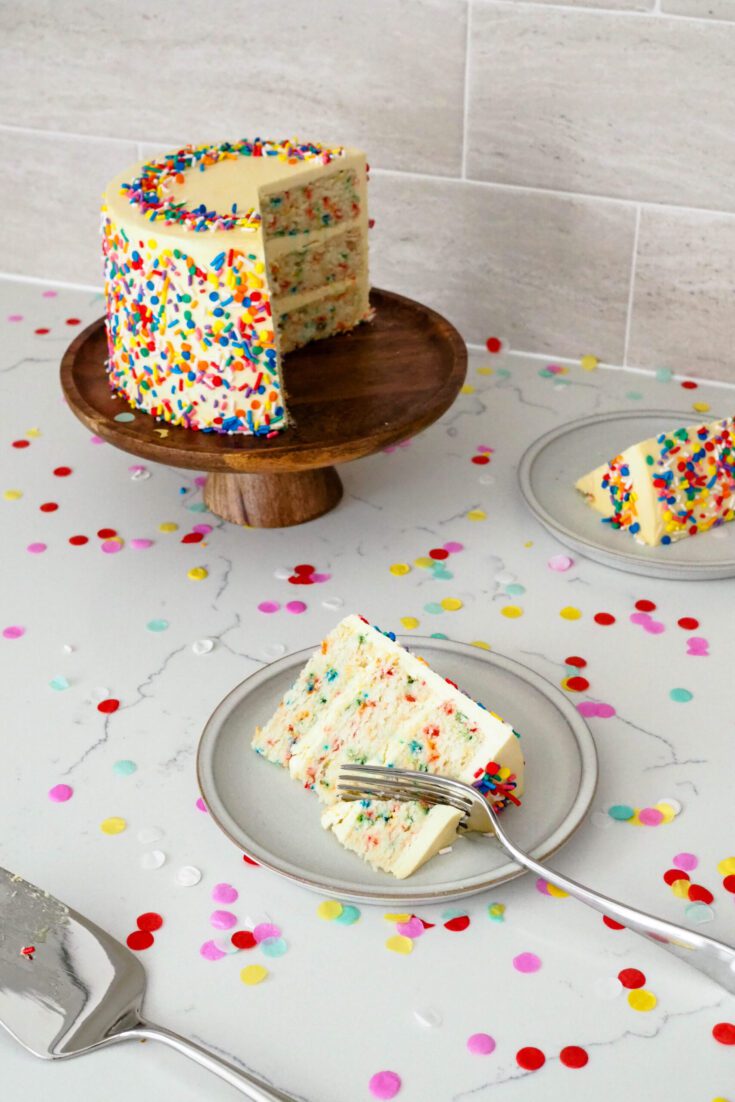
A mini birthday cake of fluffy white cake filled with sprinkles and topped with a custardy cake batter French buttercream for any occasion worth celebrating.
Ingredients
For the White Confetti Cake
- 4 egg whites, from fresh eggs (not pasteurized!)
- 1 cup granulated sugar, divided (200g)
- 8 Tablespoons unsalted butter (113g), at room temperature
- 1 ⅔ cups all purpose flour (220g)
- 1 ½ teaspoons baking powder (6g)
- ¼ teaspoon salt (1g)
- 1 Tablespoon canola oil (15 ml)
- 1 teaspoon vanilla extract or vanilla bean paste (5 ml)
- ⅔ cup whole milk (160 ml)
- ⅓ cup rainbow sprinkles (65g)
For the Birthday Cake Batter French Buttercream
- 4 egg yolks (use the ones leftover from the cake!)
- 1/2 cup granulated sugar (100g)
- 3 Tablespoons water (45 ml)
- 1 cup salted butter (226g) at room temperature
- 1 Tablespoon vanilla extract (15 ml)
- 1/2 cup powdered sugar (50g)
- 2 Tablespoons heavy cream (30 ml)
Decor
- ½-1½ cups rainbow sprinkles
Instructions
Preparation
- Preheat the oven to 350°F/175°C. Line three 6" (15 cm) cake pans with parchment rounds. Set aside.
Whip the Egg Whites for the White Confetti Cake
- This cake uses egg whites whipped with sugar to give the cake an extra lift. Make the meringue first, set it aside, and then use the reverse creaming method to make the rest of the cake before folding in the meringue.
- In the bowl of a stand mixer fitted with the whisk attachment OR a large bowl with a handheld mixer, add four egg whites from fresh eggs, as pasteurized egg whites may not whip. Save the yolks for the buttercream!
- Mix on 2 (or low) until frothy, then increase speed to 4 (medium-low).
- Once the whisk begins leaving a trail in the egg whites, sprinkle in about half of the sugar (½ cup) one Tablespoon at a time. When the sugar is incorporated, increase speed to 6 (medium) and whisk until soft peaks form.
- Transfer the meringue to a medium bowl and set aside. Wipe out your stand mixer bowl thoroughly (or use another, if you have one).
Make the Mini White Confetti Cakes
- Place the remaining ½ cup of sugar, unsalted butter, flour, baking powder, and salt into the bowl of the stand mixer fitted with a beater attachment. Mix on low until everything is fully combined and resembles bread crumbs. There should not be any large lumps. You may need to scrape down the sides and bottom of the bowl once; sometimes my batter gets compressed towards the bottom.
- Add the canola oil, vanilla extract, and milk to a measuring cup. (It won't mix together; that's fine.)
- With the mixer on low, stream the milk mixture into the stand mixer bowl. Increase the speed to medium and beat until the batter is smooth and no lumps remain, about one minute. Scrape the bottom and sides of the bowl to make sure the batter is completely combined.
- Add the sprinkles, and beat for just a few seconds until the sprinkles are mostly incorporated.
- Remove the bowl from the stand mixer base and fold in the meringue by hand with a spatula just until no streaks remain. Be sure to scrape down the sides and bottom thoroughly.
- Divide the cake batter evenly into the three cake pans and bake for 20-25 minutes until the tops are a light golden brown and the center doesn't jiggle when you remove it from the oven. *Note: Dark-colored pans may only take 20 minutes to bake.
- Leave the cakes in their pans and place on a wire rack to cool.
- Once the pans are cool enough to touch (about 15 minutes), flip the pans upside down over a wire rack to cool completely. (Line the rack with parchment paper in advance if you don't want to clean it.) Knock on the bottom of the pans if the cakes don't release immediately.
Make the Birthday Cake Batter French Buttercream
- This buttercream recipe makes just enough buttercream to fill and frost the outside of the cake with the four yolks reserved from the eggs used in making the cake. If you want extra buttercream to decorate, I'd recommend making another half batch of this buttercream recipe.
- Place room temperature egg yolks in a bowl of a stand mixer fitted with the whisk attachment and begin beating them on medium low.
- Combine the sugar and water in a small saucepan. Heat over medium heat until the syrup reaches the firm ball stage (245°F/118°C), swirling occasionally to even out any hot spots (5-10 minutes). I recommend using a candy thermometer, but any digital thermometer will do.
- Once the syrup is ready, increase the speed on the mixer to medium (speed 4) and slowly and carefully pour the syrup along the inside of the bowl, staying in one spot just outside of reach of the whisk. Try not to get syrup on the tines of the whisk, as the syrup will splatter and cool down before incorporating into the yolks.
- Once all the syrup has been poured in, increase the speed on the stand mixer to medium high. After a minute, turn off the mixer and scrape down any sugar syrup on the sides of the bowl with a silicone spatula. Then, continue whisking the yolk mixture on medium high until the bowl no longer feels warm to the touch and the yolk mixture is pale yellow and fluffy (around 7 minutes).
- While waiting, cut up your room temperature salted butter into ½" (12mm) cubes.
- When the mixture has cooled, reduce speed to medium-low and begin incorporating the salted butter into the mix, one piece at a time. If the buttercream looks like it's curdling or separating, switch to a beater attachment. Once all the butter has been added, add the vanilla extract.
- Turn off the mixer and add in powdered sugar and heavy cream. Incorporate the additions on low, then beat for 2 more minutes at medium speed to get the buttercream fluffy.
- If you want to use the buttercream right away and it feels warm, place the bowl in the fridge for just a few minutes. (This buttercream is smooth and silky, but that comes at a slight cost of melting a little faster than American buttercream.) Do not leave the buttercream in the fridge for more than 20 minutes, as the buttercream will harden too much. If the buttercream hardens in the fridge, take it out and wait for it to soften before beating it again to get a silky smooth consistency.
- Place the buttercream into a pastry bag fitted with your preferred tip, or apply straight from the bowl.
Assemble the Mini Confetti Cake
- Once the cake layers have cooled entirely, place a dollop of frosting in the center of a cake turner or stand, and then push a cake board into it to make it stick. Place another dollop of frosting in the middle of the cake board. Center a cake layer on the board.
- Pipe or spread an even layer of the birthday cake batter French buttercream on top of the cake layer (about ½ cup), then center another cake layer directly on top of it.
- Pipe or spread another layer of the birthday cake batter French buttercream on top of that cake layer (about ½ cup), then place the last cake layer on top and press firmly to seal the edges.
- Use an offset spatula to smooth a thin layer of the birthday cake batter French buttercream onto the edges and top of the cake to seal in the crumbs. Chill in the fridge for at least 15 minutes.
- Once the buttercream has hardened, frost with the remaining buttercream. Use a scraper or offset spatula to smooth the sides, scraping the excess back into the mixer bowl. For ruler-straight edges, chill for an additional half hour or until hardened, then go over the edges with a scraper once more.
- Decorate with sprinkles as desired!
Notes
Store your mini confetti layer cake in an airtight container in the fridge for up to four days. (The French buttercream in this recipe requires refrigeration for food safety.)
Take the cake out of the fridge an hour before you plan to serve it for the best flavor and texture.
Recommended Products
As an Amazon Associate and member of other affiliate programs, I earn from qualifying purchases.
Nutrition Information:
Yield:
8Serving Size:
1Amount Per Serving: Calories: 490Total Fat: 20gSaturated Fat: 10gTrans Fat: 0gUnsaturated Fat: 9gCholesterol: 152mgSodium: 211mgCarbohydrates: 70gFiber: 1gSugar: 49gProtein: 8g
The nutrition facts are estimated and may vary based on specific ingredients used.
Thanks for trying out my mini confetti layer cake recipe! Please consider rating this recipe so others find it, too.
I’d love to see how your recipe turns out: Take a photo and tag me on Instagram @floralapronblog to share with me, or use the hashtag #floralapronbakes.
This post contains affiliate links. If you click through and make a purchase, I may receive a small commission at no cost to you. Thank you for helping to support The Floral Apron!



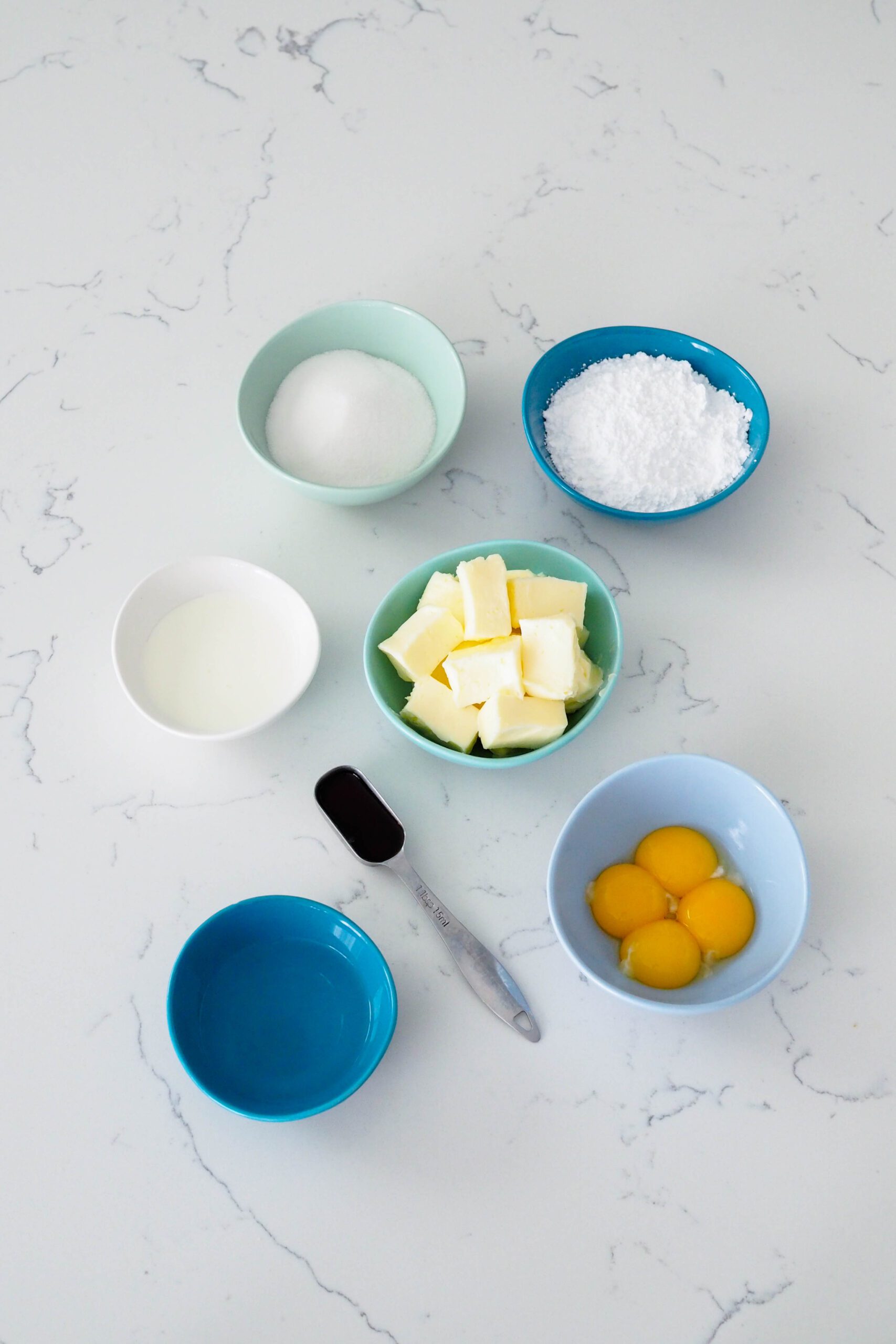
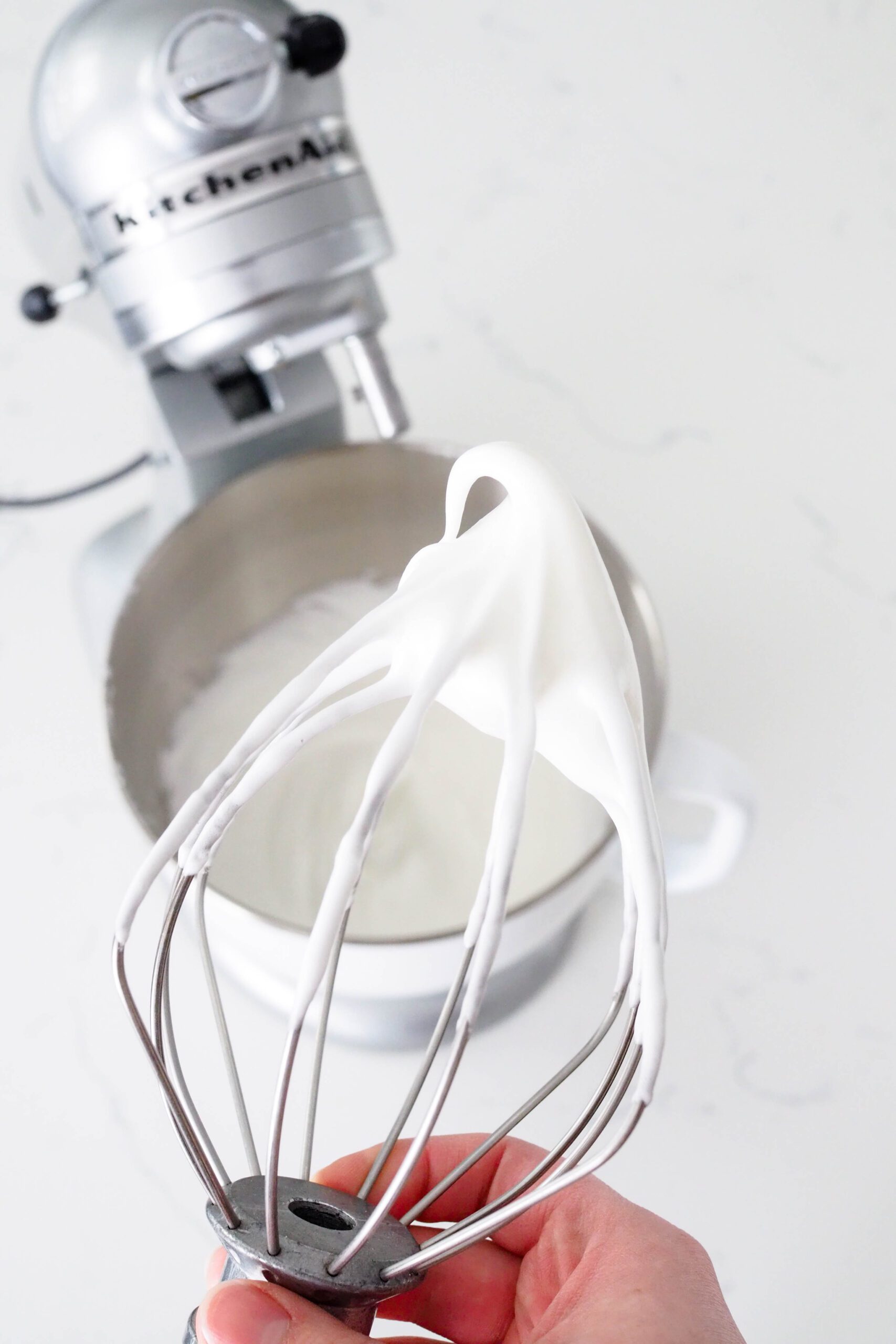
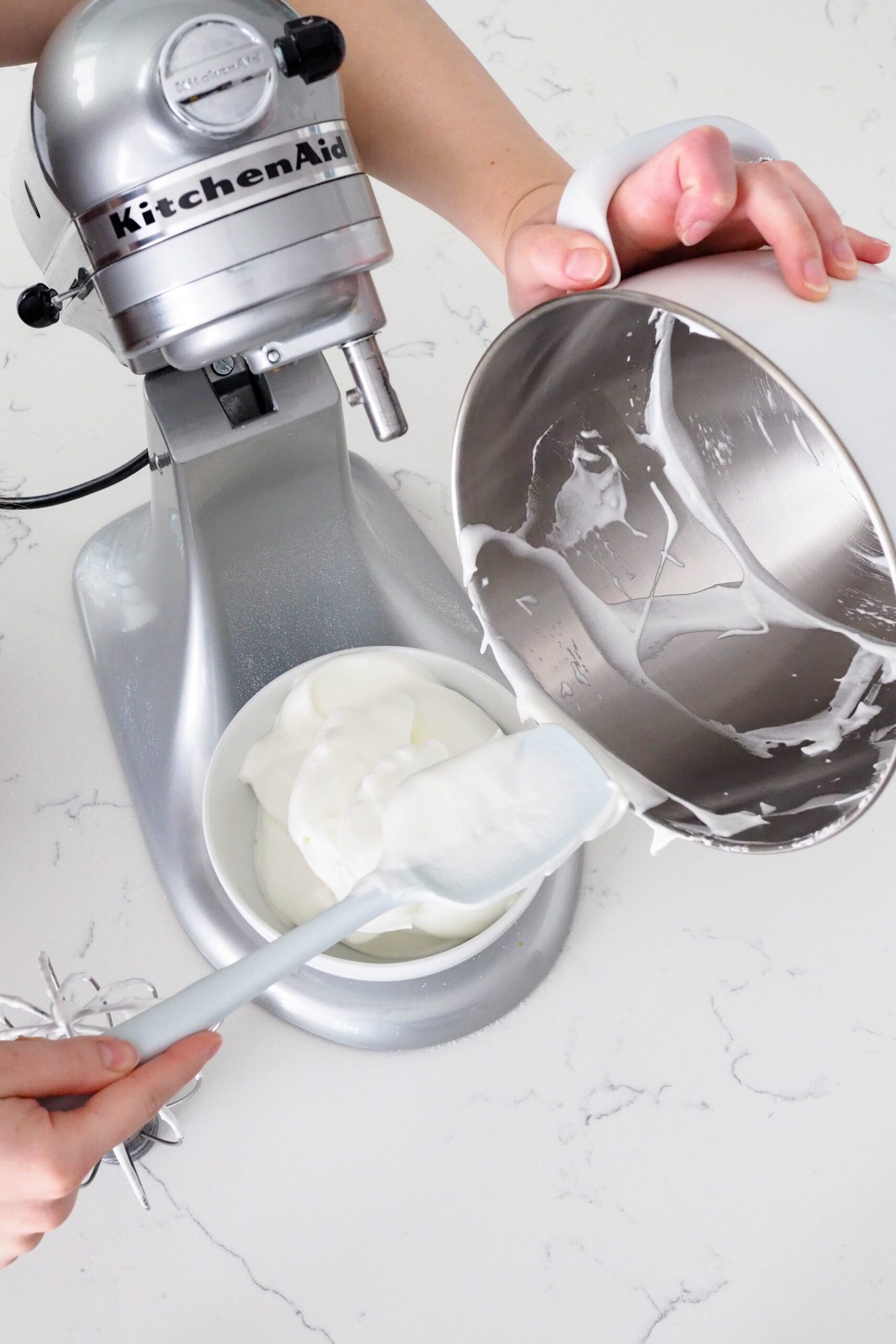
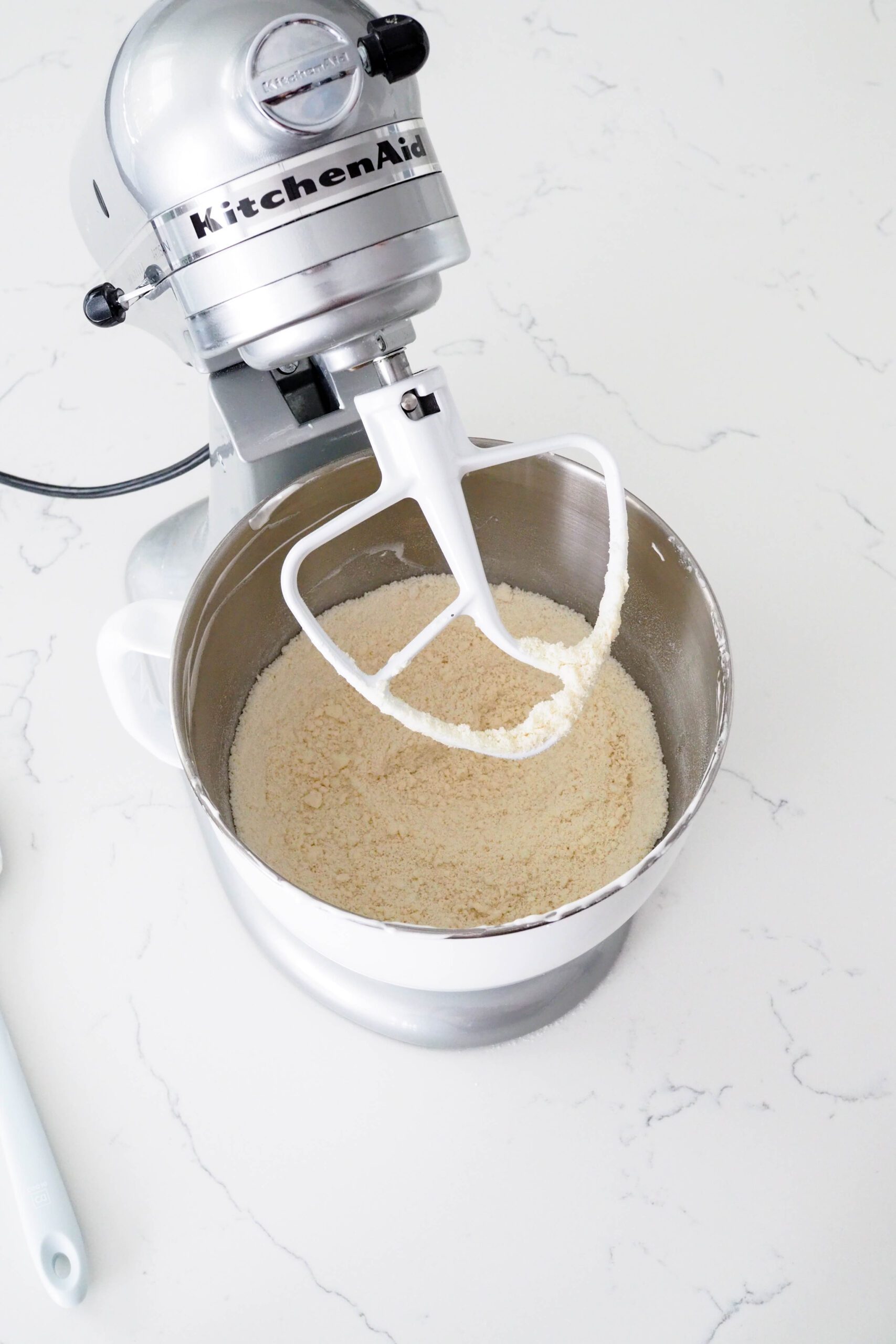
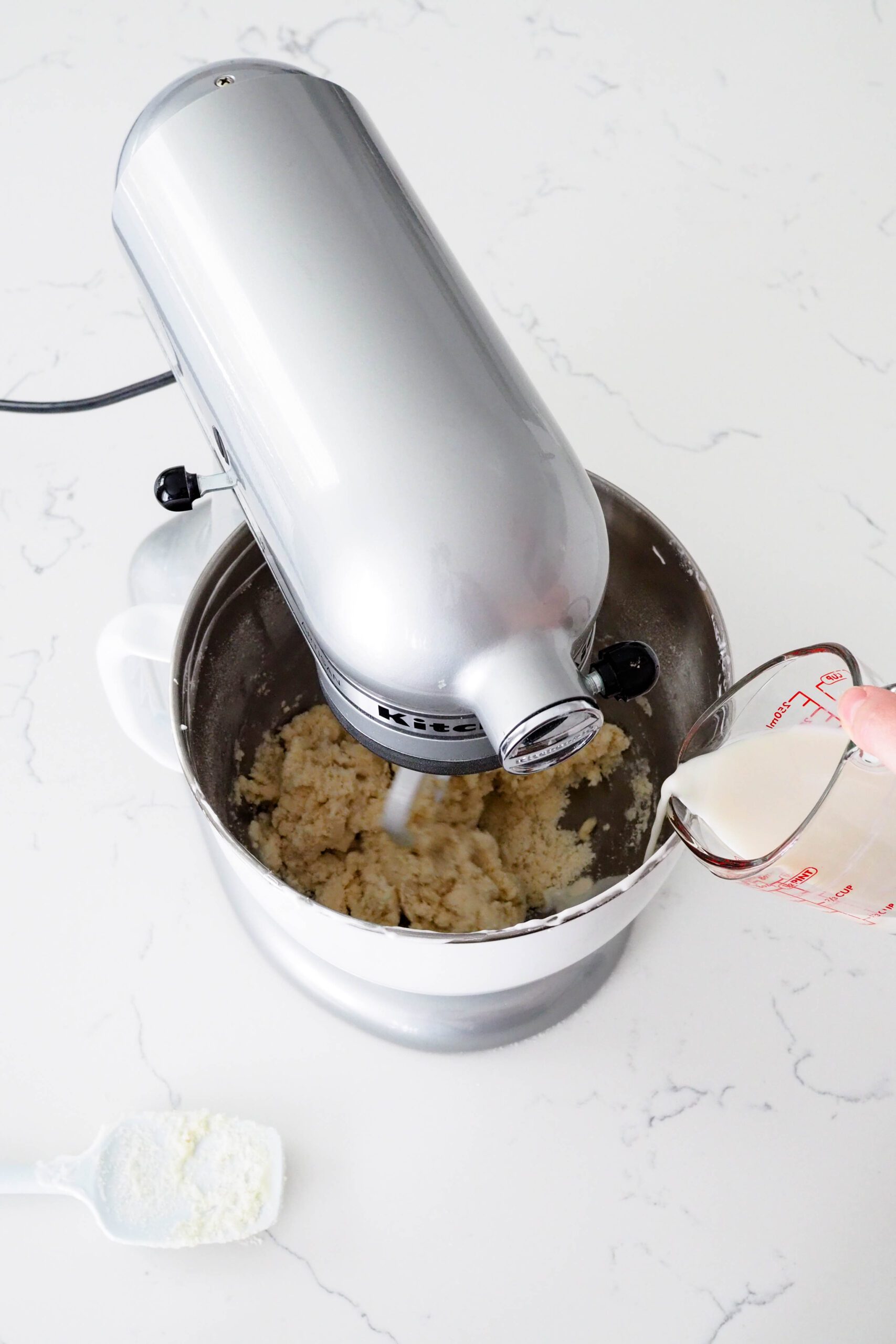


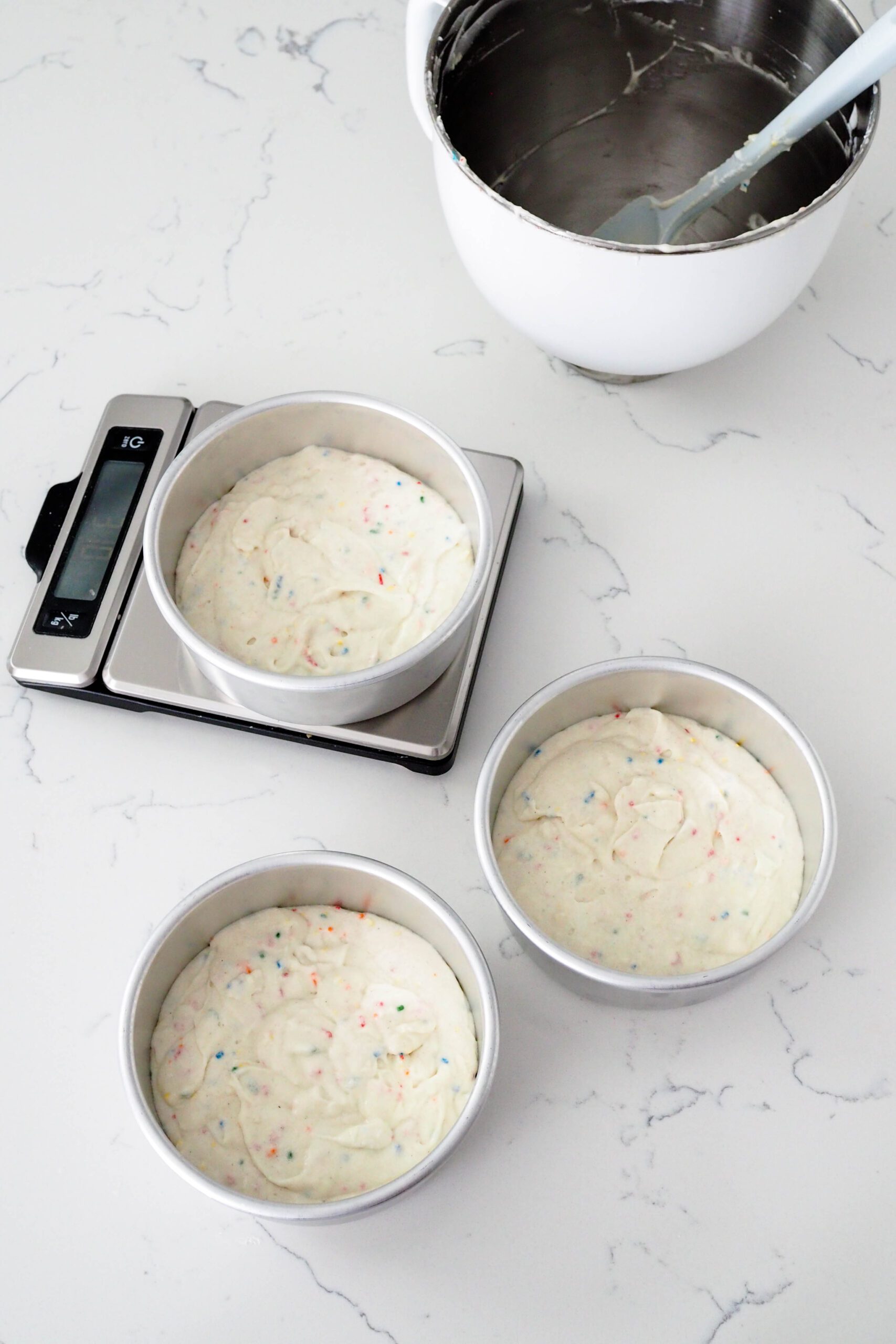

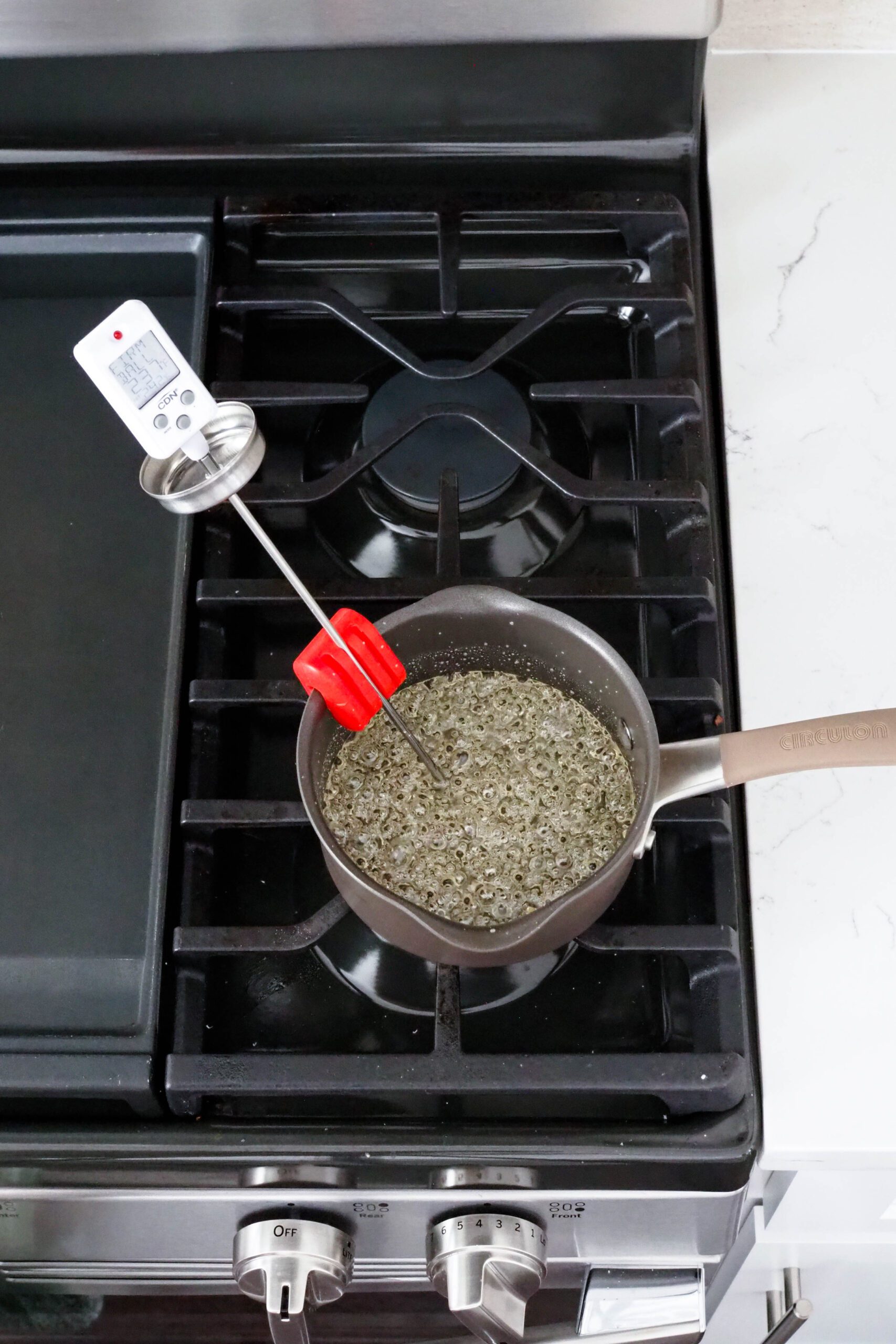





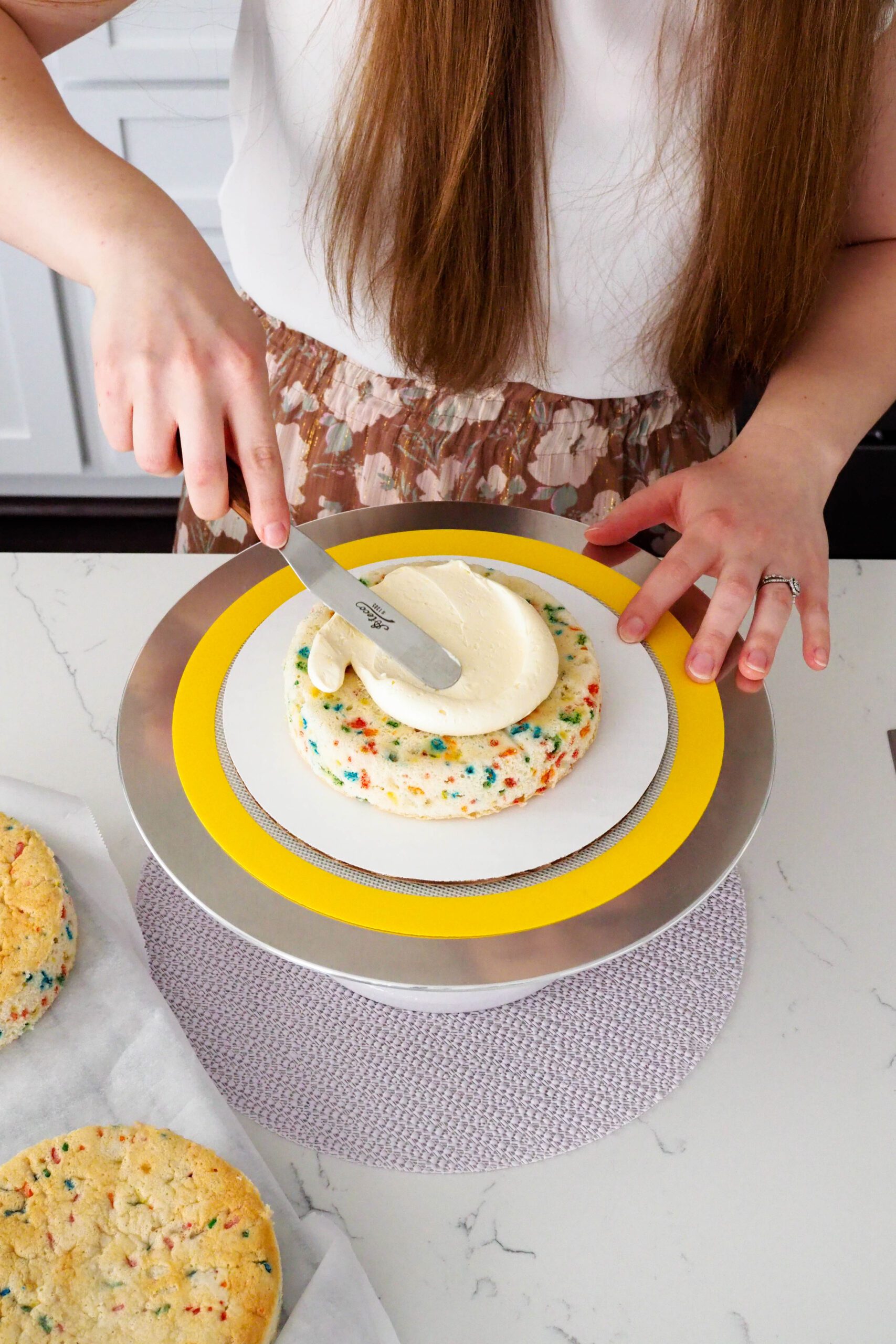

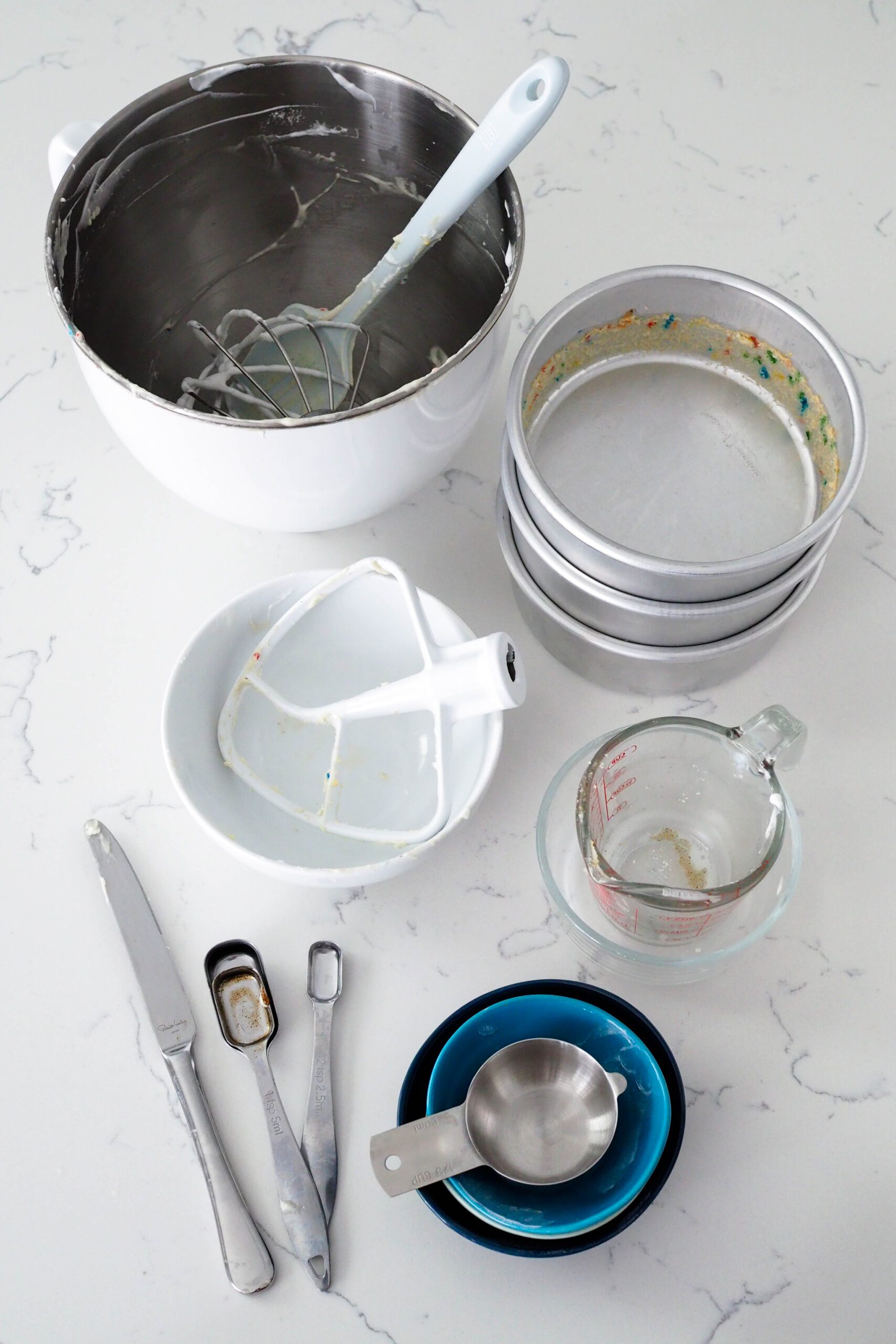
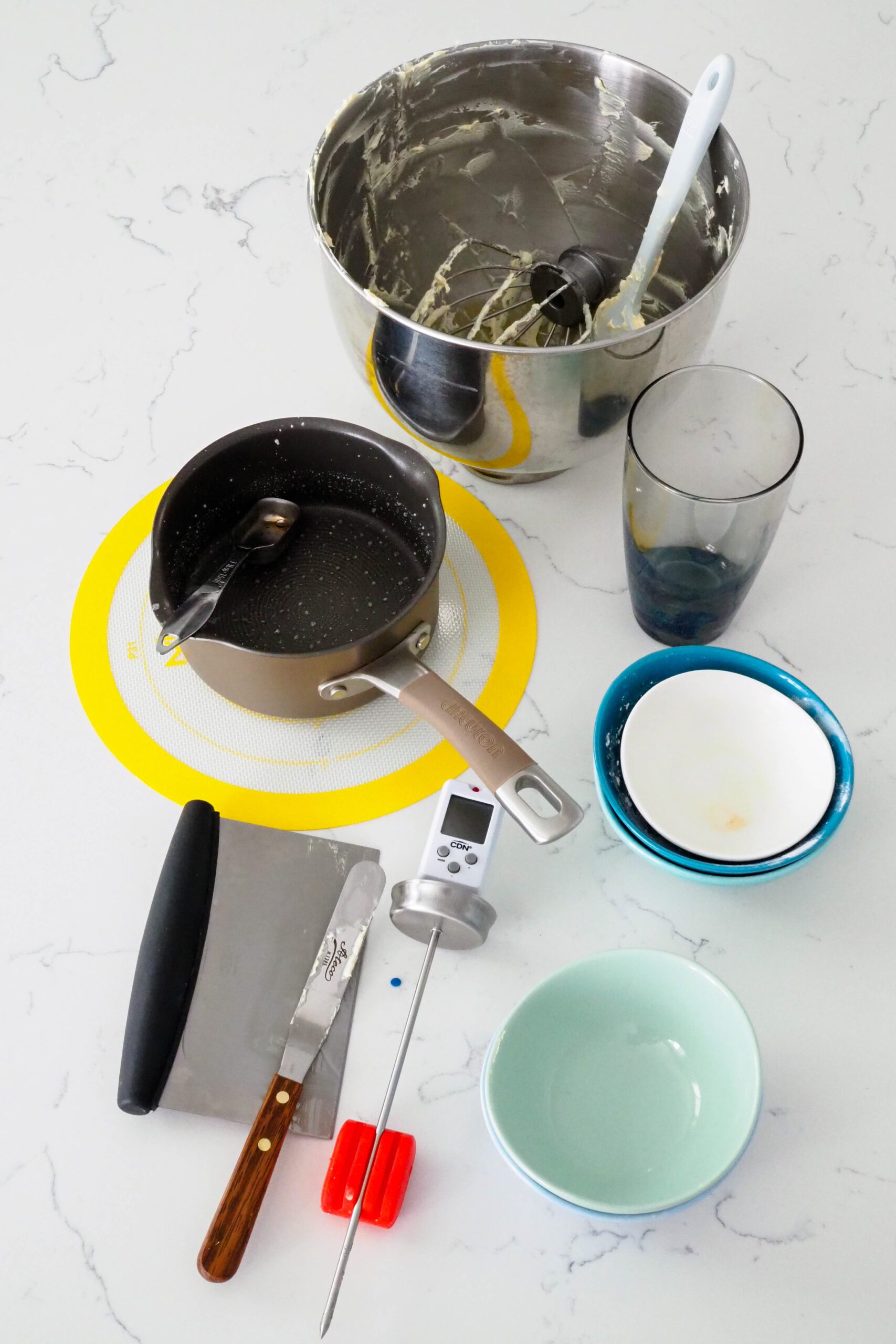



I’ve never had that problem with egg whites. With the price of eggs lately regular ones are perfectly fine.
I’m not sure the exact problem you mean with egg whites. I’m guessing it’s the distinction between pasteurized and unpasteurized egg whites I noted in the recipe ingredients, is that right?
The vast majority of eggs in-shell (what I’ve called “fresh eggs”) available in US grocery stores will work for this recipe, as they are not pasteurized. It’s the pasteurized eggs and egg whites in a carton that you want to avoid, as they may not whip up into a meringue.
Some people have success getting pasteurized whites to whip, but others have trouble. I pointed out the distinction so people don’t waste their money and time trying to whip egg whites that may not turn into meringue for them 🙂
Or maybe “fresh eggs” sounds more like eggs fresh from a farm and not just eggs in-shell. Even some eggs in-shell are pasteurized, so I think the distinction is helpful!
If neither of those answers were helpful in clarifying the recipe, please let me know so I can try again! 🙂